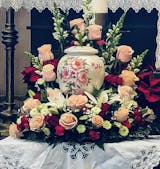How to Choose a Cremation Urn
Cremation urns offer us a chance to determine the final resting place for our loved one’s ashes. Each cremation urn is designed for a particular use. Urns are made from different materials, and many are stylized.
To help sort out how to choose an urn, consider the question, “What do I want to come of this? What is it for?”1 By clarifying your goal at the outset of the process, the situation assumes meaning. And meaning will assist you in narrowing the selection of urns to a choice that fits your needs.
To begin, ask yourself a few basic questions.
- How will the urn be used?
- Will a burial urn be used for an earth burial or perhaps placement in a memorial garden?
- Will the cremation urn be used for a scattering service?
- If the remains are to be scattered, where will this take place?
- Will the final resting place be in a mausoleum or a columbarium?
- Will the urn be kept as a memento in the home or shared in jewelry such as necklace urns for ashes?
- Will the urn have to travel, perhaps needing to pass TSA requirements2 for airport security?
- Should a biodegradable urn be a consideration to reduce environment impact?
- Will a specialized service be planned that might include service groups, military, or police personnel?
To further assist you, visit our informative articles on scattering ceremonies, regulations related to scattering ashes, shipping or traveling with remains, memorial urns, biodegradable urns, and mementos.
Once the initial purpose for the cremation urn has been established, the selection process can be refined further by determining what type of material would be most appropriate.
- What materials would be most suitable for the intended use?
The final resting place and purpose of the urn will help to determine what type of material would be a suitable choice. Here are some general guidelines to help with your selection.
Burial urns
-
A permanent burial urn is one that will not lose its form or structure due to natural elements. It preserves the cremation ashes secure into perpetuity. Burial urns made of stone, such as marble or granite and hard metals of bronze or stainless steel, are good choices, as are enameled cloisonné’s. Cremation urns such as these are appropriate for interment, entombing in a mausoleum, or resting in a columbarium niche.
- Biodegradable urns, or non-permanent burial urns, are ones that will slowly disintegrate over time, releasing the remains into the ground as the materials gradually break down. As there’s a growing trend for ecologically friendly burials, more people are choosing environmental stewardship3 for cremation urns, and a greater selection of products are becoming available. As well as being made of non-toxic and eco-friendly materials, many urns in the “green” category are:
- Made of sustainable elements that can be harvested in a continual manner for environmental protection
- Some of the biodegradable urns currently available are made of non-toxic and natural materials such as Himalayan rock salt, handcrafted papers made from Mulberry bark, corn starch, coconut shell, gelatin mixed with sand, and bamboo.
- Another unique version of the biodegradable urn are the living legacy trees that combine eco-friendly urn materials with the seed of a tree, such as oak, maple, gingko, pine, and ash. These urns are then planted, and as they break down and mix with earth and water, a seedling sprouts and grows.
Urns for a scattering memorial
For scattering services, many of the available funeral urns are lightweight and beautifully made from natural materials in the form of paper scattering tubes, water soluble urns for scattering on water, biodegradable urns for releasing into nature, and fabric urns made of silk.
Keepsake and memorial urns
- For purposes of keeping a memento and sharing ashes, the following ideas are worth considering. Memory boxes, vases, bottles with stoppers, picture frames, and candle holders come in a large variety of shapes and smaller sizes for keeping in the home. Keepsake jewelry such as necklace urns for ashes is also a popular way to retain a small portion of the cremation ashes after scattering or burial.
- Rings, bracelets, pendants, necklace urns for ashes, key chains, and lockets are some of the personal items that can serve as keepsake urns.
- Cremation urns that will remain in the home, on a display shelf or mantle, can retain their quality of longevity with lighter materials such as wood, glass, or ceramics.
- What style of cremation urn would be most appropriate?
- Again, the styles or themes available for funeral urns are virtually limitless. Giving consideration to the deceased’s personal wishes, if available, will guide your direction. If none were left, it may be helpful to think about your loved one's personality, passions, hobbies, or special interests.
- Styles range from artistic hand-blown glass, patriotic themes, and specialty interests such as gardening, music, sports, auto enthusiasts, and religious motifs.
- In addition to the above, funeral urns can be further stylized by engraving with a favorite quote or poem, painting, embossing and three-dimensional detailing. And of course, urns can be left as is without any kind of adornment.
Your choice of a cremation urn will undoubtedly pay homage to your loved one, as well as leave you with a sense of resolution. And, by asking yourself a few simple questions, you’ll be well on your way to handling a situation that could otherwise be challenging.
References:

